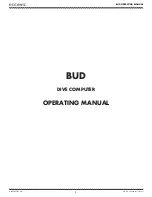
9. Additional Information
65
DA-650/-645/-640
9-2. Glossary and reference
Given in this section are “Measurement principle of oscillation-type density
meters” and “Glossary and reference (incl. tables of air and pure water).”
Measurement principle of oscillation-type density meters
Suppose a weight hangs at the end of a rod. When the weight is flipped by a
finger, the rod starts to vibrate. When the weight is heavy, it swings slowly. If
it is light, it swings fast. This means the frequency depends on the mass of
weight. Since density value is proportionate to mass, the density of unknown
substance can be known by measuring the frequency of weight in cubic if the
cubic volume is constant.
When the measuring is vibrated in a chamber filled with liquid or gas, its
oscillation frequency differs from density of sample.
Suppose T is oscillation frequency, T can be expressed as follows:
K
Mc
dVc
T
+
=
π
2
Where d = Density of sample in cell
Vc = Volume of sample, that is cell volume
Mc = Mass of measurement cell
K = Constant
Vc
Mc
T
Vc
K
d
−
=
2
2
4
π
The above equation tells the density is proportionate to the frequency.
By measuring standard substance of which density is known (density: da, dw),
the oscillation frequency Ta, Tw are obtained, and then factor F.
F can be calculated from calibration.
2
2
2
4
w
a
w
a
T
T
d
d
Vc
K
F
−
−
=
=
π
Therefore, density is obtained by measuring oscillation frequency T of
unknown substance.
d
d
F T
T
a
a
=
−
−
(
)
2
2
Содержание DA-640
Страница 2: ......
















































